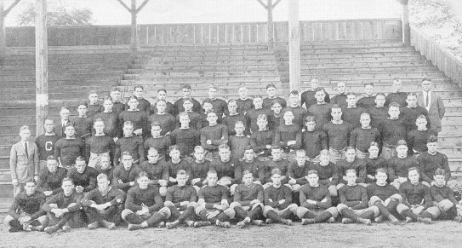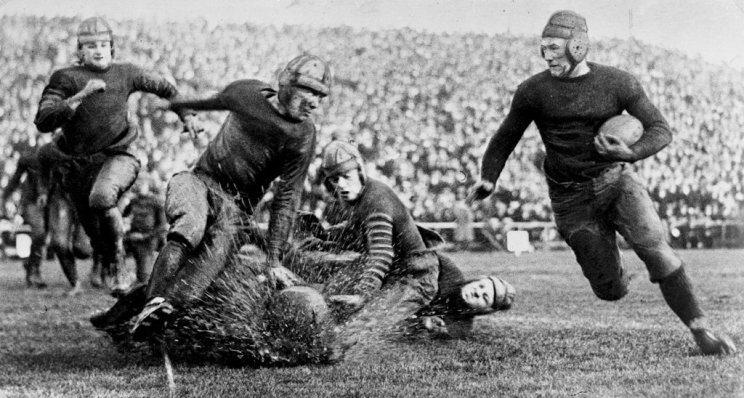
Defending national champion California's 18 game winning streak came to an end on the rain-swamped field of the Rose Bowl, as they were shocked and outplayed by Washington & Jefferson (with the ball in the picture above) in a 0-0 tie. That outcome leaves the 1921 mythical national championship (MNC) rather murky.

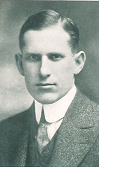 This
was Iowa's first perfect season, and their first Big 10 title in 21
years, but they didn't come out of nowhere-- they had been building
their way up to this moment for years, going 6-2-1 in 1918 and 5-2 in
both 1919 and 1920. They followed this year's 7-0 with another 7-0 in
1922, the only perfect seasons in Iowa history, as well as their only
consecutive Big 10 titles.
This
was Iowa's first perfect season, and their first Big 10 title in 21
years, but they didn't come out of nowhere-- they had been building
their way up to this moment for years, going 6-2-1 in 1918 and 5-2 in
both 1919 and 1920. They followed this year's 7-0 with another 7-0 in
1922, the only perfect seasons in Iowa history, as well as their only
consecutive Big 10 titles.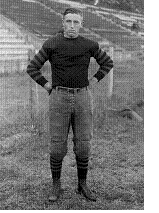 Iowa's
one consensus All American this season was quarterback and captain
Aubrey Devine (pictured at left). A Hall of Famer, he also handled the
team's punting, placekicking, and returns, and he led the team in
rushing, passing, and scoring all 3 years he played for Iowa. He kicked
a field goal to beat Minnesota 9-6 in 1919, and scored all of his
team's points in wins over Northwestern and Iowa State the same season.
He ran for one touchdown and threw for the other in a 14-7 win over
Indiana in 1920, and led the Big 10 in scoring that season.
Iowa's
one consensus All American this season was quarterback and captain
Aubrey Devine (pictured at left). A Hall of Famer, he also handled the
team's punting, placekicking, and returns, and he led the team in
rushing, passing, and scoring all 3 years he played for Iowa. He kicked
a field goal to beat Minnesota 9-6 in 1919, and scored all of his
team's points in wins over Northwestern and Iowa State the same season.
He ran for one touchdown and threw for the other in a 14-7 win over
Indiana in 1920, and led the Big 10 in scoring that season.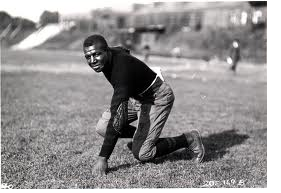 In
his next game, Locke carried the ball 37 times for 202 yards, scoring
both touchdowns to beat Illinois 14-2, but he was hospitalized after
the game with stomach problems that hampered him the rest of the
season. He still finished with over 700 yards and was 3rd in the
conference in scoring. In 1922, when he carried the team offensively,
he scored a touchdown in an 8-7 win over Illinois, 3 touchdowns in one
half against Minnesota, 2 touchdowns in a 12-9 win over Ohio State, and
4 touchdowns in his collegiate finale against Northwestern. His 72
points in Big 10 play that season were the most by a conference back
until 1943. He totaled 32 touchdowns in his career, 4 times scoring 4
in a single game. Like
Devine, he became a lawyer after graduation.
In
his next game, Locke carried the ball 37 times for 202 yards, scoring
both touchdowns to beat Illinois 14-2, but he was hospitalized after
the game with stomach problems that hampered him the rest of the
season. He still finished with over 700 yards and was 3rd in the
conference in scoring. In 1922, when he carried the team offensively,
he scored a touchdown in an 8-7 win over Illinois, 3 touchdowns in one
half against Minnesota, 2 touchdowns in a 12-9 win over Ohio State, and
4 touchdowns in his collegiate finale against Northwestern. His 72
points in Big 10 play that season were the most by a conference back
until 1943. He totaled 32 touchdowns in his career, 4 times scoring 4
in a single game. Like
Devine, he became a lawyer after graduation.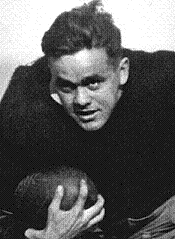 Cornell had previously won one MNC, in 1915
Cornell had previously won one MNC, in 1915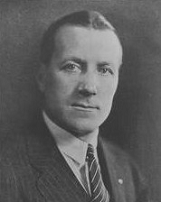 Lafayette
had once been a fairly powerful football school, the highlight being
1896, when they went 11-0-1 and tied 10-0-1 Princeton, the 2 teams
sharing a mythical national championship that season. If there had been
an AP poll in the early 20th century, they would have been ranked in
the final top 25 ten times from 1901-1911, though rarely in the top 10.
But the wheels came off in 1912, and 1912-1918 they went 29-31-5, and
would not have been ranked once. Thusly might they have remained
forever had they not hired Hall of Fame coach Jock Sutherland in 1919
Lafayette
had once been a fairly powerful football school, the highlight being
1896, when they went 11-0-1 and tied 10-0-1 Princeton, the 2 teams
sharing a mythical national championship that season. If there had been
an AP poll in the early 20th century, they would have been ranked in
the final top 25 ten times from 1901-1911, though rarely in the top 10.
But the wheels came off in 1912, and 1912-1918 they went 29-31-5, and
would not have been ranked once. Thusly might they have remained
forever had they not hired Hall of Fame coach Jock Sutherland in 1919